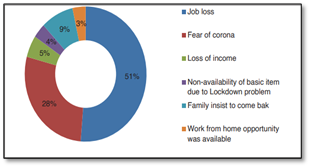Monday, 19th July 2021
Midday meals leave a long-lasting impact: study
In News
A new study by the University of Washington and International Food Policy Research Institute has attempted an inter-generational analysis of the impacts of India’s midday meal (MDM) scheme.
Key Findings
- This research uses data on mothers and their children spanning 1993 to 2016, to assess whether MDM supports intergenerational improvements in child linear growth.
- The study finds that Girls who had access to the MDM at government schools, had children with a higher height-to-age ratio (Lower stunting) than those who did not.
- Linkages between midday meals and lower stunting in the next generation were stronger in lower socio-economic strata and likely work through women’s education, fertility, and use of health services.
Significance of these findings
- These findings are important given the high prevalence of stunting in India. According to National Family Health Survey-4, 38% of children were stunted in 2015–2016.
- Linear growth failure is a marker of chronic under nutrition. Stunted children are at risk of not reaching their developmental potential, thus stunting has large implications for human capital and the economic productivity of entire societies.
- The fight against stunting has often focused on boosting nutrition for young children, but maternal health and well-being is the key to reduce stunting in their offspring. Girls in India finish school, get married and have children all in just a few years — so school-based interventions can really help.
- Other impacts of MDM- On learning outcomes - Another study in 2019 by IIM Calcutta, correlated the number of months children had school meals with their performances in reading and mathematics tests–and noticed significant improvement.
About MDM scheme
- Launched in 1995 by the Government of India, the MDM scheme provides a free cooked meal to children in government and government-assisted primary schools. The scheme guidelines envisage providing cooked mid-day meal with 450 calories and 12 g of protein to every child at primary level and 700 calories and 20 g of protein at upper primary level.
- Objective: To enhance the enrolment, retention and attendance and simultaneously improve nutritional levels among school going children studying in Classes I to VIII of Government, Government - aided schools, Special Training centres and Madarasas and Maktabs supported under the Sarva Shiksha Abhiyan.
- It comes under Ministry of Education.
Conclusion
A recent UN report presented evidence on the potential short and long-term negative effects of the disruption to school meal schemes during the COVID-19 pandemic globally. Although foodgrains or cash transfers have been provided to families instead, this would not have the same impact as hot cooked meals, especially for girl children who face more discrimination at home and are more likely to drop out of school due to the closures. The key takeaway is to expand and improve school meals now for inter-generational pay-offs.
Source:
- Midday meals leave a long-lasting impact: study
- New study finds India’s national school meal program linked to improved growth in children of beneficiaries
- Intergenerational nutrition benefits of India’s national school feeding program Intergenerational nutrition benefits of India’s national school feeding program
- The correlation between midday meals and learning outcomes
- Mid day meal scheme
Aiming for Sustainable Habitat: New Initiatives in Building Energy Efficiency 2021
In News
“Aiming for Sustainable Habitat: New Initiatives in Building Energy Efficiency 2021” was launched by Bureau of Energy Efficiency.
About the News
- Power Minister announced various initiatives for the buildings sector which is expected to become the largest energy consumer by 2030, surpassing the industry.
- These initiatives will help enhance the energy-efficiency levels in residential buildings across the country, thereby leading to sustainable habitation. BEE, under Ministry of Power, co-ordinates with designated consumers, agencies and other organizations to recognise, identify and utilise the existing resources and infrastructure.
- An energy-efficient building creates comfortable living conditions inside the dwelling with the least possible amount of energy consumption maximizing efficiency in use of resources.

The Initiatives for Building Energy Efficiency 2021
- Eco Niwas Samhita 2021: A model code and verification framework for minimum energy performance requirements for building services. There is a plan for amendment of the Energy Conservation Act to make legal framework applicable for the residential sector. This code will come very handy as and when we make it legally mandatory.
- Training: The BEE will also train over 15,000 architects, engineers and government officials on Energy Conservation Building Code (ECBC) 2017 and Eco Niwas Samhita (ENS) 2021).
- Online Star Rating tool: It was announced for energy efficient homes to improve energy-efficiency and reduce energy consumption in individual homes. It provides performance analysis to help professionals decide the best options to pick for energy-efficiency of their homes.
- The Handbook of Replicable Designs for Energy Efficient Residential Buildings’: A web-based platform ‘The Handbook of Replicable Designs for Energy Efficient Residential Buildings’ was also launched at the event as a learning tool which can be used to create a pool of ready-to-use resources of replicable designs to construct energy-efficient homes in India.
- NEERMAN Awards: National Energy Efficiency Roadmap for Movement towards Affordable & Natural Habitat (NEERMAN) was announced with the goal of encouraging exceptionally efficient building designs complying with BEE’s Energy Conservation Building Codes.
- Online Directory of Building Materials: The directory envisages the process of establishing Standards for energy efficient building materials.
Sources:
Covid -19 Pandemic and Livelihood Loss
In News
Loss of income and livelihood are among the top concerns for rural communities struggling to cope with the effects of the COVID 19 pandemic, according to a new study conducted across 10 states.
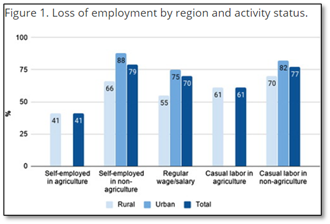
About the News
- According to the International Labour Organization (ILO), nearly 25 million jobs have been lost worldwide due to the pandemic.
- Key providers of employment, such as manufacturing, tourism and hospitality, travel, services and retail industries, along with small and medium enterprises, bore the acute brunt of Covid-19.
- The issue is that while there was an acknowledgement of the need for social distancing and self-isolation and the pre-eminence of human lives and well-being, there were growing concerns over adding to the severity of economic and social impact that the lockdown would have on the country.
Reasons for livelihood loss during the pandemic
- Supply chain disruption: The pandemic affected the entire supply chain, with border closures, trade restrictions and confinement measures. Supply chain has had major problems to cope with an unpredicted demand for certain products. As a consequence of greater uncertainties in supply and demand, there has been a huge employment loss in the entire chain.
- Effect on MSMEs: The pandemic has had a disproportionate impact on the MSMEs. The median net sales of MSMEs fell by 47% (y-o-y) during Q1 FY21. After the lockdown, many MSMES were operating at an average of only 11% of capacity, with 56% producing nothing at all. This led to 35-40 million job losses in MSMEs.
- Weak Demand: One of the biggest challenges that the Covid-hit economy faced is dwindling demand, due to several reasons like lower consumer footfall, weak consumer sentiments and mobility restrictions due to lockdowns in most parts of the country.
Impact of the Livelihood loss
- Agricultural workers: Millions of agricultural workers – waged and self-employed – when faced income losses, resorted to negative coping strategies, such as distress sale of assets, or child labour. Migrant agricultural workers have been particularly vulnerable, because they face risks in their transport, working and living conditions and struggle to access support measures put in place by governments.
- Informal workers: Informal employment is marked by low earnings, precarious working conditions, weak or absent social protection, and dependence on day-to-day earnings for sustenance. Many of the workers were not able to access the same employment options as before. To meet daily living expenses, they borrowed money, which has increased the risk of them falling back into poverty.
- Gendered Perils: The pandemic also aggravated prevalent gender inequalities and vulnerabilities. Covid-19 has unevenly impacted women and girls in the domains of health, economy, social protection, and gender-based violence.
- Increased Disparities: Disparities have increased as higher-paid workers are working from home while lower-paid blue-collar workers typically do not have this option, higher share of low-paid workers are in essential services such as nursing, policing, teaching, cleaning, refuse removal, and store attendants where they are more likely to come into contact with people who are infected, and lower paid workers are more represented in the sectors that have suspended activities such as hotels, restaurants and tourism services.

Future strategies for restoration and creation of means livelihood
- Labour Market Policies: The recent data from National Career Service portal of Ministry of Labour and Employment highlights that jobseekers are disproportionately higher in states other than the states where vacancies and employers are located. These facts necessitate that labour market policies need to recognise the requirement of labour mobility. Portability of the identity, and benefits such as food, social security should be part of labour market policies.
- Reforms in non-farm sector: The return migration to the rural areas provides opportunity to rethink about developing the rural non-farm sector in a major way. Should the migrant population travel back to the cities, the preparation needs to be made in a more tangible way to strengthen the functioning of the urban informal economy and slum living which would comprise considerable overlaps among housing, employment and health interventions.
- Strengthen Informal Economy: The challenges faced by the informal workers will have to be mitigated by looking into their social-security needs, work conditions and wage outcomes. The informal economy strategy will have to be prioritised in order to enhance the productivity and earnings of the workers so that the future urban growth becomes more inclusive and sustainable.
- Worker Registry: There is no proper national-level registry for the poor and those involved in informal jobs. There is urgent need for these registries to be instituted, along with a dynamic unemployment registry to provide direct economic (universal basic income), health (universal coverage), and other necessary contingency protection and support.
- Revitalize the Farm Sector: Due to reverse migration, villages have vast numbers of people who would require jobs to sustain themselves. Already distressed farm sector cannot accommodate such an enormous rural population. Hence the government needs to spend not only on revitalising the farm sector through appropriate policy interventions.
Conclusion
As the economic and social disruption caused by the pandemic is devastating, we must recognize this opportunity to build back better. There is need to develop long-term sustainable strategies to address the challenges facing the health and agri-food sectors. Priority should be given to addressing underlying food security and malnutrition challenges, tackling rural poverty, in particular through more and better jobs in the rural economy, extending social protection to all, facilitating safe migration pathways and promoting the formalization of the informal economy.
Question: Analyze the impact of the pandemic on the livelihood of people and suggest measures to cope with such livelihood crisis in the future
Primary Sources:
- COVID-19 Pandemic and Livelihood Loss: Variations in Unemployment Outcomes and Lessons for Future
- Impact of COVID-19 on people's livelihoods, their health and our food systems
- The impact of COVID-19 on migrant women workers in India
- ILO: As job losses escalate, nearly half of global workforce at risk of losing livelihoods
- Migrants’ Misery and Livelihood Mapping: The Unfinished Agenda
- COVID 19 Scare and Plight of Indian Migrant Workers: Decoding the Impact of Nationwide Lockdown
- Covid-19 Impact: Lockdown and Livelihood in the Lurch
- 25-30 million lost jobs in MSMEs during March-June, says survey
This Day in History – Mangal Pandey
On 19th July, 1827, Mangal Pandey was born. He was a soldier whose attack on British officers on March 29, 1857, was the first major incident of what came to be known as the Sepoy Mutiny. Pandey joined the army of the British East India Company in 1849. He was made a soldier (sepoy) in the 6th Company of the 34th Bengal Native Infantry. A commemorative postage stamp with his image on it was issued by the Indian government in 1984.

Source:
Image source:
Image of the Day – Germany Floods
The image is of massive landslide and resultant sinkhole in a flood-damaged town in northern Germany. The unprecedented rainfall is being referred to as the worst such event that the country has witnessed in nearly a century. The catastrophic flooding in Germany was caused by a severe storm and continuous rains that caused rivers and streams to swell up and flood the towns and cities. The extreme weather event comes in the same week that the European Union made the announcement to reduce 55 per cent of its greenhouse gas emissions by the year 2030.

Sources:
Image source:
UMANG App.
- Context: Ministry of Electronics & Information Technology (MeitY) has inked MoU with MapmyIndia to enable map services in UMANG App.
- The UMANG mobile app (Unified Mobile Application for New-age Governance)is a Government of India single, unified, secure, multi-channel, multi-platform, multi-lingual, multi-service mobile app that provides access to high impact services of various organizations (Central and State).
- It provides seamless integration with the Aadhaar and other applications like Digilocker and PayGov.
- Through this alliance, citizens will be able to find government facilities nearest to their location, such as mandis, blood banks, view the driving distance, get directions and turn by turn voice and visual guidance to locations, including traffic and road safety alerts during navigation at the click of a button.
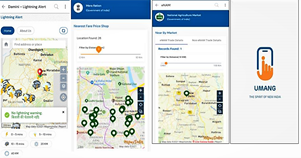
Source:
- Ministry of Electronics & IT enables map services in “UMANG App”; Signs MoU with MapmyIndia
- MeitY inks MoU with MapmyIndia to enable map services in UMANG App
Picture source:
Kisan Sarathi
- Context: Digital Platform 'Kisan Sarathi' was launched recently.
- It was jointly launched by the Union Minister for Agriculture and Farmers' Welfare and the Union Minister of Electronics & Information Technology.
- It is a digital platform to facilitate farmers to get ‘right information at right time’ in their desired language.
- With this platform, the farmers can interact and avail personalized advisories on agriculture and allied areas directly from the respective scientists of Krishi Vigyan Kendra (KVKs) - anagricultural extension center in India.

Source:
- 93rd Foundation day of Indian Council of Agriculture Research celebrated virtually
- Krishi Vigyan Kendra
Image source:
China’s Emission Trading System
- Context: China’s national carbon market, the world’s largest emissions trading system was launched recently.
- Emissions trading systems (ETS) are market-based instruments that create incentives to reduce emissions where these are most cost-effective.
- In most trading systems, the government sets an emissions cap in one or more sectors, and the entities that are covered are allowed to trade emissions permits.
- ETS exposes emitters to the external costs of emissions in the most flexible and least costly way and those polluters who find it costly to reduce their emission are allowed to buy emission allowances from polluters that can abate at lower costs.
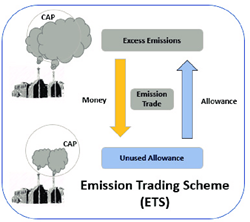
Source:
Picture Source:
US India Business Council (USIBC)
- Context: Finance Minister addresses USIBC Roundtable organized on "Maximizing India's Sustainable and Inclusive Growth as Global Destination for US Investment'.
- The U.S.-India Business Council was formed in 1975 as a business advocacy organization to enlighten and encourage the private sectors of both India and United States to enhance investment flows.
- The Council helps in making business between the United States and India easier, more efficient, and more profitable.
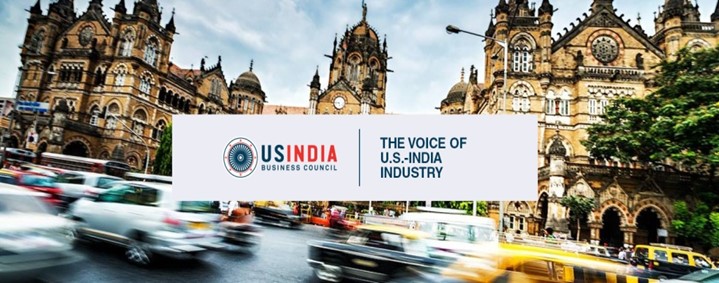
Source:
Image source:
Calculating the benefits of lockdowns – The Hindu
Essence: Data show that as of now 26.2% of the world population has received at least one dose of a COVID-19 vaccine. Of them, only 1% live in low-income countries. How long it will take to eliminate the inequality in the administration of vaccines is shrouded in mystery. This article takes a stock of long or short lockdowns studies their effectiveness in economic terms.
Why you should read this article?
- Understand the trilemma which Lockdowns poses between life, livelihood and quality of life.
- Know about the social and economic cost associated with lockdown vis-à-vis value of human life.
Source:
What the new Ministry of Cooperation needs to achieve – Indian Express
Essence: Editorial is discussing India’s cooperative sector, it’s journey so far, major challenges & expectations from new Ministry of Cooperation at Union level. India’s tryst with the cooperative movement has produced mixed results — few successes and many failures. There are cooperatives in the financial sector, be it rural or urban. But the performance of these agencies when measured in terms of their share in overall credit, achievements in technology upgradation, keeping NPAs low or curbing fraudulent deals has been poor to average.
Cooperatives desperately need technological upgradation. Ministry of Cooperation should give them soft loans for innovation and technology upgradation. But why not extend the same terms to the private sector and see the magic of transforming India? A level-playing field is critical to see which model suits India the best.
Why you should read this article?
- To understand the background of structural reforms in Indian economy & its impact on cooperative sector.
- To gain insights into milk cooperative sector & its comparison with private dairy industry.
- To know about the impact of intar-state difference in milk subsidy.
- It is also providing critical analysis on cooperative model not being that successful in finance & sugar industry
Source:
People’s support must for population policies – Hindustan Times
Essence- Recent release of the Uttar Pradesh (UP) draft population control bill has once again raised a debate over coercive measures to population control in India. India will be the most populous country in the world by the turn of the century and balance of the population is important now. But according to various survey, total fertility rate (TFR) is falling due to factors such as economic status, education and health care affect, etc. A population policy cannot be seen in isolation from the people it affects. It is a social policy; hence, we need to take into account the people’s needs. Therefore, India should focus on health, nutrition, education and economic policies. If this is done, population will take care of itself.
Why should you read this article?
- To get an overview of issue of population control all over India and where India stands at global level.
- To get an overview of TFR in India and factors responsible for the same.
- To understand why coercive measure is not the solution and what possible steps should be taken to address the same.
Source:
Innovative ways of Teaching: Sheri Shikshan Initiative
Background
- Open classes are part of the Gujarat’s Sheri Shikshan (street education) initiative that was for children who had been left out of the virtual learning programme.
- With thepandemic forcing schools shut since last year, teachers are now holding classes for in open spaces like public parks, temple complexes.
Hurdles faced by the teachers
- Resistance from the parents to send their children to study in places other than their school.
- Concern for the girl child: Parents of girls had raised the objection about sending their daughters to study in a public space.
Benefits of the programme
- Improved attendance: The response of children has been quite encouraging as the children are not confined to a room or a building. It has ensure around 75% attendance.
- Better learning outcome: In online medium, small kids could barely understand as they couldn’t concentrate. Sheri Shikshan initiative has led to better learning outcome.
- Overcome the issue of digital divide: Many children did not own smart phones so impating knowledge was a difficult task. Sheri Shikshan initiative tried to overcome the issue of digital divide in innovative manner.
Sources:
Share the article
Get Latest Updates on Offers, Event dates, and free Mentorship sessions.

Get in touch with our Expert Academic Counsellors 👋
FAQs
UPSC Daily Current Affairs focuses on learning current events on a daily basis. An aspirant needs to study regular and updated information about current events, news, and relevant topics that are important for UPSC aspirants. It covers national and international affairs, government policies, socio-economic issues, science and technology advancements, and more.
UPSC Daily Current Affairs provides aspirants with a concise and comprehensive overview of the latest happenings and developments across various fields. It helps aspirants stay updated with current affairs and provides them with valuable insights and analysis, which are essential for answering questions in the UPSC examinations. It enhances their knowledge, analytical skills, and ability to connect current affairs with the UPSC syllabus.
UPSC Daily Current Affairs covers a wide range of topics, including politics, economics, science and technology, environment, social issues, governance, international relations, and more. It offers news summaries, in-depth analyses, editorials, opinion pieces, and relevant study materials. It also provides practice questions and quizzes to help aspirants test their understanding of current affairs.
Edukemy's UPSC Daily Current Affairs can be accessed through:
- UPSC Daily Current Affairs can be accessed through Current Affairs tab at the top of the Main Page of Edukemy.
- Edukemy Mobile app: The Daily Current Affairs can also be access through Edukemy Mobile App.
- Social media: Follow Edukemy’s official social media accounts or pages that provide UPSC Daily Current Affairs updates, including Facebook, Twitter, or Telegram channels.



